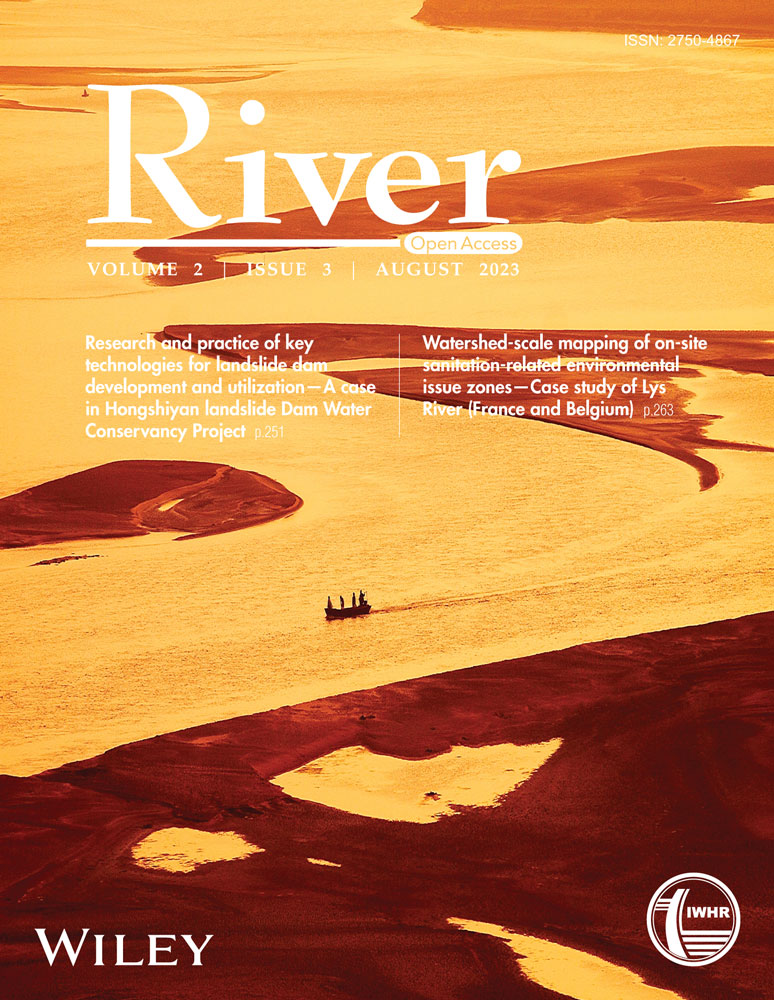Research and practice of key technologies for landslide dam development and utilization—A case in Hongshiyan landslide Dam Water Conservancy Project
Abstract
Based on the emergency rescue, the subsequent disposal, and the development and utilization projects of the Hongshiyan Landside Dam in Ludian, Yunnan, China, research has been conducted on key technical issues facing the development and utilization of landside dams, including the possibilty evaluation of development and utilization, structure analysis of wide gradation material, performance evaluation, investigation and design, dam seepage control, construction technology and equipment, and safe operation assessment. And innovative results has made in all seven aspects mentioned above, writing the history in this field. The achievements were directly applied to the development planning, investigation and design, construction, and operation and maintenance of the Hongshiyan Landside Dam, a comprehensive water conservancy project that integrates flood control, water supply, irrigation, and power generation, with significant comprehensive benefits.
1 INTRODUCTION
As a special natural earth–rock dams, landslide dams are generally formed due to the blockage of valleys by earthquakes, rainfall, landslides, and debris flows, resulting in backwaters in the upstream section, while barrier lakes are formed when the original water system is blocked by the damming body. For lakes formed to a certain extent, the source of the barrier body may be the collapse deposits caused by rainfall, earthquakes, human factors, and so forth, or the accumulation of volcanic lava flows, glaciers, and snowmelt ice deposits. The formation of barrier dams is usually caused by unstable geological conditions. After the formation of landslide dams, the obstructions will also be affected by scouring, erosion, landslides, and dissolution. Severe secondary flood disasters may occur if not treated barrier dams in time, it may collapse and damage downstream areas.
At 16:30 on August 3, 2014, an earthquake of magnitude 6.5 occurred in Ludian County, Yunnan Province. On the mainstream of Niulan River at the junction of Lijiashan Village, Huodehong Township, Ludian County, and Hongshiyan Village, Baogunao Township, Qiaojia County, Due to the earthquake, the mountains on both sides of the bank collapsed to form barriers, which caused great damage to the downstream. The earthquake caused 617 deaths, 112 missing, 3143 injuries in Ludian County, Qiaojia County, Zhaoyang District, Yongshan County, Zhaotong City, and Huize County, Qujing City, and 8172 people were transferred; 28 reservoirs in 5 counties were damaged. About 446,000 mu of irrigated area was affected; many rural water supply facilities and water supply pipelines were damaged, affecting 377,000 people. To prevent the secondary damage caused by the landslide dam and the unstable slopes on both sides, ensure the productive resettlement of the victims of the landslide dam, ensure the safety of the landslide dam, and turn the Hongshiyan landslide dam into treasure, and transform harm into benefit. The dam is treated under dangerous situations, reinforced and developed and utilized in a comprehensive way.
The basic emergency response plan for Hongshiyan landslide dam: excavate the discharge trough on the top of the barrier lake as quick as possible, and at the same time dredge the flood discharge channel on the right bank as soon as possible to lower the water level of the lake, reduce the storage capacity, reduce the risk of dam burst, and reduce the potential risky impact to the downstream. After the emergency response is completed, to improve flood response standards, plans such as deep excavation of discharge channels and new construction of flood discharge tunnels connected to diversion tunnels will be considered in the follow-up disposal stage.
After the emergency response was completed, the Hongshiyan Dammed Lake Disposal Headquarters issued a document consigning the POWERCHINA Kunming Institute fully undertake the follow-up disposal and post-renovation projcet of the Hongshiyan Dammed Lake, turning waste into treasure and transform harm into profit, implemented as soon as possible as a postdisaster reconstruction project.
After preliminary analysis, the Hongshiyan landslide dam is large in scale and relatively stable, and it is very difficult and will take immerse expensive to dismantle. If it is allowed to be washed away by the flood and collapse, it will easily trigger a disaster chain, which will endanger the downstream existed Huangjiaoshu and the Tianhuaban hydropower stations and the safety of people, houses, and farmland on both sides of the river, so the comprehensive treatment of barrier lakes is imminent. At the same time, if the landslide dam is rectified, the water supply and irrigation conditions of relevant townships in Ludian County, Qiaojia County, and Zhaoyang District can be improved, and water sources can be guaranteed for local social and economic development; the dam can be fully utilized by turning waste into treasure. The formed reservoir generates electricity and provides clean and high-quality energy for the social and economic development of the local area and Yunnan Province; the rectification project will form a barrier lake characteristic tourist area and stimulate local tourism.
However, at present, there is a lack of corresponding theories and technologies for the development and utilization of landslide dams, and the development and utilization evaluation theory, disease and danger treatment, design, reinforcement treatment, and safety assurance technologies are obviously insufficient. The development and utilization of barrier dams is facing major scientific and technical challenges. The emergency rescue environment of the barrier lake is dangerous, the conditions are harsh, and the time is tight. The emergency response is extremely difficult, and the structure of the landslide barrier body is complex, and the risk of secondary disasters induced by demolition is high. Technical bottlenecks such as state evaluation, survey and design, dam seepage control, construction technology and equipment, and safe operation evaluation.
2 KEY TECHNOLOGIES FOR THE DEVELOPMENT AND UTILIZATION OF LANDSLIDE DAMS
In summary, the resource development and utilization of barrier lakes mainly include power generation, water supply reservoirs, ecotourism, fishery, land reclamation, and so forth. Comprehensive evaluation of social economy and so on. However, there is no ready-made theory and method for reference on how to evaluate it. The following is the research and exploration done in this paper, and the results fill in the gaps in this field.
2.1 Evaluation method of landslide dam development and utilization
According to the analysis requirements for the development and utilization of landslide dams, by comprehensively obtaining the basic data for the development and utilization of landslide dams, a multidimensional development and utilization comprehensive evaluation mathematical model and judgment criteria for engineering safety, resources, economy, and ecological environment were established. A comprehensive evaluation model and method for the development and utilization of landslide dams for flood control and disaster reduction, water supply and irrigation, social ecology, and power generation are proposed, and a comprehensive evaluation program for the development and utilization of landslide dams is developed (Figure 1). According to the comprehensive development and utilization of the Hongshiyan landslide dam, the conclusion is relatively desirable.
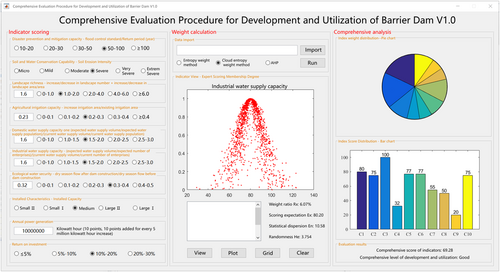
2.2 Structural analysis method for wide gradation materials
At present, the rapid analysis technology of wide-graded materials has defects such as small observation range, easy to be interfered by the visual condition, large amount of data, and slow data processing. This paper develops the identification and detection technology of the external shape and spatial structure of the damming body, and proposes a method for rapid identification of the apparent particle size of the damming body and determination of material parameters. First of all, a rapid identification method of damming body particle size based on Cany image edge detection and convolutional neural network model was proposed, and a gradation identification system based on digital image processing technology was developed (Figure 2). Second, the criteria for judging block rock area, gravel area, and breccia area were established, and a method for quickly determining the material parameters of the damming body was proposed. Combined with comprehensive research and judgment such as geological surveying and engineering analogy, the material properties and parameter value ranges were determined, and the developed soil parameter determination software. Third, through the research of in situ detection methods in the hole and on the surface, a comprehensive comparison of multiparameter comprehensive evaluation system of the damming body is formed, the physical characteristics and material parameters of the damming body are revealed, and the wave velocity, amplitude, vibration frequency, dispersion characteristics, and so forth. A series of studies on the physical properties of barrier dam materials, evaluation of the compactness characteristics of barrier dams, and providing a basis for the stability evaluation and construction treatment of barrier dams.

2.3 Working performance and long-term deformation evaluation of landslide dam
The environment in which landslide dams are located is complex and changeable, so they experience frequent coupling effects of multiple processes. To understand the working behavior and long-term evolution mechanism of barrier dams, it is necessary to accurately describe the multiscale interaction characteristics of the above-mentioned multibody and multiprocess. However, the existing rock–soil mass evaluation methods cannot satisfy the performance evaluation of barrier dams. In this paper, a new three-dimensional elastic-plastic damage constitutive model of the interface and a macro–mesocosmic integrated model of damming materials are developed. The centrifugal model testing technology of barrier dams independently developed which reveal the mechanism of multibody interaction; and a new method for analyzing the working performance of barrier dams is constructed.
2.3.1 Long-term deformation analysis method for integration of dam body and slope
In this paper, the three-dimensional stress-deformation analysis of the Hongshiyan dam was carried out by using the integrated calculation theory of dams and its software, revealing the coupling law between the particle damage of the damming material and the stress–strain, and clarifying the interface between the damming material and its structure. A viscoelastic-plastic constitutive model considering static loading-rheological unidirectional coupling was established, and an integrated long-term deformation analysis method for dam body and slope was developed. According to the geological exploration data of Hongshiyan dam, a three-dimensional finite element calculation and analysis grid was established, with a total of 48,695 elements and 63,512 nodes (Figure 3). Figure 4 shows the application deformation of the typical longitudinal section of the antiseepage wall construction.


2.3.2 Three-dimensional elastic-plastic damage model of soil-structure interface
To reveal the static and dynamic characteristics of the interface between dam material and concrete. For this type of interface, the large-scale soil-structure interface three-dimensional static and dynamic test equipment was used to carry out two-dimensional and three-dimensional cyclic shear test research (Rehman et al., 2020; Rehman & Zhang, 2021a). Based on the three-dimensional constitutive law of the interface and the elastic-plastic damage interface model framework, a three-dimensional elastic-plastic damage model is established, (Rehman & Zhang, 2021b). A three-dimensional constitutive model was established based on the research results (Rehman & Zhang, 2019; Zhang et al., 2006, 2010, 2011; Zhang & Zhang, 2006a, 2006b, 2008, 2009a, 2009b, 2009c, 2009d) of interface strength, shear and its coupling, dilation, compression, and physical state evolution characteristics. Ascertained the multibody interaction mechanism of the barrier dam, established the macro–microcosmic integrated constitutive model of the barrier dam, proposed the integrated calculation theory of the barrier dam and developed software, and revealed the evolution mechanism of the long-term working performance of the barrier dam and the law of spatial variation. The stress of the diaphragm wall after impoundment of the Hongshiyan project is shown in Figure 5.
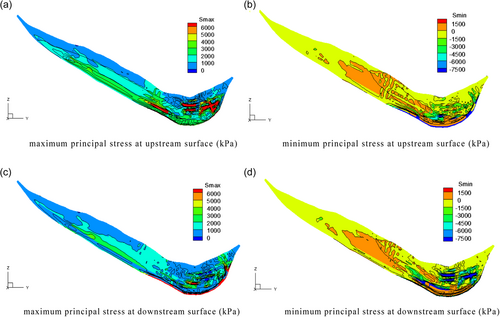
2.3.3 Size effect analysis method and long-term behavior calculation analysis model
The size effect analysis method and the long-term performance calculation and analysis model of barrier dams are proposed. The logistic distribution function model of particle crushing strength was established, and the particle size correlation formula of the parameters of the Duncan Zhang EB model for granular materials was proposed; it was found that the wetting strain direction and the average principal stress p and the generalized shear stress q have a torsional relationship, and the proposed A new wetting strain model; a particle strength model that can consider the long-term deterioration and crushing process is proposed, and the long-term behavior evolution law of particle accumulations under the influence of complex environmental factors is analyzed.
The safety evaluation and analysis of the dam body is carried out from the aspects of seepage, deformation and stability, which have the characteristics of wide gradation, large particle size, unevenness and low compactness (Figures 6-8). To reveal the long-term behavior evolution law of the damming body in a complex environment, and propose a size effect analysis method and a long-term behavior calculation and analysis model.
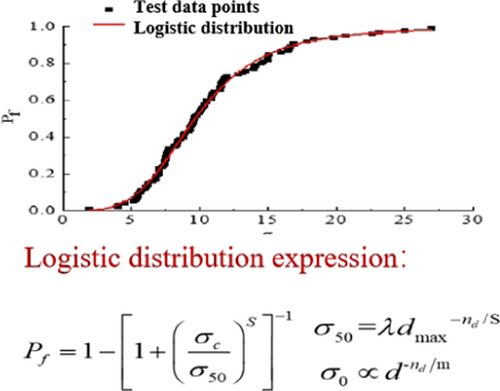
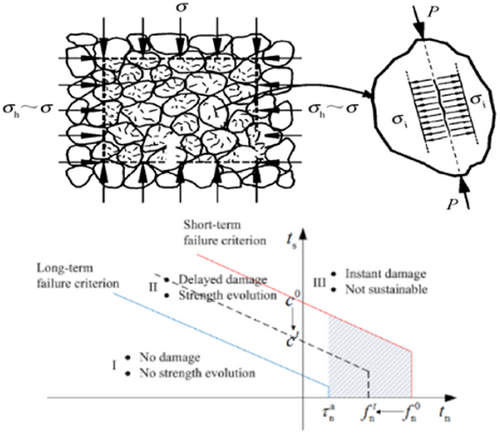
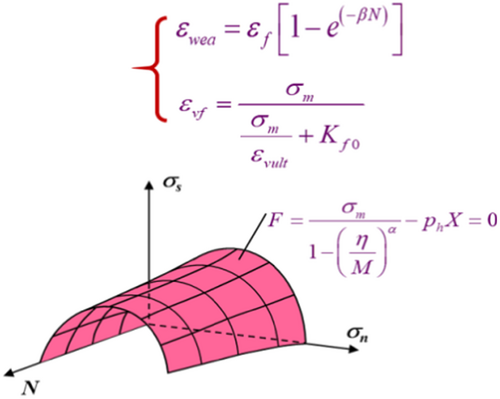
2.3.4 Macro–microcosmic integrated constitutive model of damming material
Through experiments to observe the macroscopic mechanical properties and mesoscopic structural response of the damming material, a macro–mesocosmic integrated constitutive model of the damming material is established, which reasonably describes the basic macroscopic mechanical properties of the damming material, such as nonlinearity, compaction, dilatancy, and so forth; developed the evolution equation of dam material breaking and rheological model of interface; through the self-developed centrifuge model test of dam, revealed the interaction between dam body and antiseepage structure, dam body and foundation slope. To understand the mechanism of action, an integrated long-term deformation analysis method for dams and slopes was proposed, and a numerical calculation software was developed. Relying on the Hongshiyan landslide dam project, the integrated calculation of the landslide dam was carried out, the random characteristics of the spatial variability of the barrier dam were analyzed, and the influence of the overhead structure and seepage spatial variability on the stress, deformation and seepage characteristics of the landslide dam was studied. It reveals the variation law of the working performance of the landslide dam.
2.4 Landslide dam survey and design technology
2.4.1 Landslide dam survey and design system
The landslide dam has the feature of large undulations, many boulders, serious overhead phenomena, deep accumulation, uneven material composition, and no obvious layered structure, the general survey methods, especially geophysical methods, do not have the working conditions. In this paper, innovations have been made in survey methods, instruments and equipment, result interpretation and processing systems, and so forth, and a comprehensive survey technology system for landslide dams has been established, which has broken through the technical bottleneck of obtaining physical and mechanical parameters of landslide dams. Hereby mainly include:
- 1.
Adopting comprehensive geophysical prospecting technology combining passive source surface wave method, transient electromagnetic method, high-density electrical method, comprehensive logging, and so forth, we have developed landslide dam structure detection, material testing and integrated monitoring equipment and technology, and developed landslide dam comprehensive geophysical method interpretation software, combined with geological surveying and mapping and comprehensive interpretation of intensive survey results, improves the exploration accuracy.
- 2.
The elastic wave detector in the borehole of the in situ accumulation material of the dam was developed from the aspects of the source, the receiver, and the data collector, and the hidden dangers of the structural characteristics of the dam accumulation were developed based on the multisource surface wave method and elastic wave computed tomography technology. Detection technology and equipment, developed a large-scale high-pressure horizontal penetration test chamber.
- 3.
For the first time, a 1.5 m large-diameter exploration shaft was arranged on the crest of the barrier dam, with a maximum depth of 97 m, and the material composition of the barrier dam was accurately ascertained and the physical and mechanical indicators were proposed.
- 4.
Developed the three-dimensional geological system for landslide dam engineering for the first time, promoting the application of three-dimensional geological modeling technology in the investigation of landslide dams under complex conditions (Figure 9).

2.4.2 Design system for landslide dam development and utilization
The design technology system for the development and utilization of barrier dams was constructed, and the antiseepage design structure of the combination of barrier dam cut-off walls and ancient landslide body curtain grouting was proposed for the first time, creating a precedent for barrier dams to reduce disasters and promote benefits. (1) Considering the functions of flood control and disaster reduction, ecological restoration, water supply and irrigation, power generation, and regional social development, a collaborative planning and design system for the development and utilization of barrier dams and comprehensive disaster prevention was proposed. (2) A design system for project layout adapted to the specific dam site of the barrier dam is constructed. The Hongshiyan barrier dam water conservancy project includes the barrier dam, the spillway tunnel on the right bank, the sand flushing hole on the right bank, the water diversion system and the power plant, water supply and irrigation buildings, and so forth. (3) Developed a full-professional hydro-bilding information mode (BIM) collaborative design platform for emergency treatment of barrier dams, realized data collection and processing, full-professional data flow through, full-professional BIM collaborative design, engineering computer aided design/computer aided engineering and benefit evaluation integration, and improved work efficiency and quality. (4) For the first time, a new structure of 130 m discontinuous wide-graded dam body comprehensive utilization antiseepage design was proposed. Curtain Grout Combo. (5) A dynamic design and remediation technology for high and steep slopes fractured by 800 m strong earthquakes is proposed. Aiming at technical problems such as the continuous collapse of slope blocks after the earthquake and the inaccessibility of personnel, a refined three-dimensional topographic and geological model of high and steep slopes was constructed, and a divisional and phased improvement plan was proposed to realize the dynamic design of high slope improvement.
2.5 Antiseepage technology of dam body
At present, the antiseepage and reinforcement treatment technology of landslide dams is not mature, and there are not many examples of the successful use of seismic landslide dams in China. The more famous ones are Chongqing Xiaonanhai Reservoir seismic landslide dam, and so forth the references to antiseepage treatment of Hongshiyan dam are very limited. In view of the fact that the permeability of the Hongshiyan dam foundation is mostly medium to weak permeable layer, local strong permeable layer, and there may be seepage damage, full-section antiseepage is considered, and a combination of damming antiseepage wall and ancient landslide body curtain grouting on the left bank is used to form new antiseepage solution.
2.5.1 Dam body antiseepage wall scheme
According to the surface monitoring results of the damming body, the density of the downstream side of the damming body is higher than that of the upstream side after formation, and the deformation convergence tends to be more stable. The slag is deflected downstream. The antiseepage of the dam body adopts the antiseepage wall and antiseepage curtain, and the antiseepage on both sides is grouted through the grouting hole, as shown in Figure 10.

2.5.2 Curtain grouting solutions
The lower part of the concrete cut-off wall is connected to the curtain grouting to the 5Lu line. Due to the deep deposits on the left bank, to avoid disturbing the deposits on the left bank by excavation, a grouting hole was excavated within the deposit on the left bank, and the grouting hole was extended to connect with the groundwater level. A grouting hole and a single row of curtains are set up in the slope of the collapsed body on the right bank. The grouting hole is supported by lining and the section of the D shape tunnel is in the shape of a hole. The grouting hole is lined with concrete in the accumulation body and highly weathered bedrock.
2.6 Research and development of landslide dam construction technology and equipment
At present, the construction technology of landslide dams is not mature, and there are not many examples of successful development and utilization of seismic landslide dams in China. There is a lack of construction equipment for loose, wide-graded, and high-overhead rockfill bodies. The current construction technology and equipment are difficult to adapt to this kind of construction. This project has carried out comprehensive research and development in construction technology, materials, and equipment, and has broken through the technical bottleneck of landslide dam construction technology and equipment.
2.6.1 New material development
Limited by the performance of the existing self-flowing grouting materials, the self-flowing control grout cannot effectively fill the gaps below the millimeter level. The grout stability indicators such as delamination and water retention are poor, the ability to resist water dilution is poor, and the mechanical strength of the consolidated body is not good. For these issues, this project has developed two new materials, silica sol nanoscale environmentally friendly grouting materials and cement paste, to solve the technical problem of filling grouting materials for wide-graded landslide dams.
Silica sol environment-friendly grouting material has the characteristics of low viscosity, low cost, good groutability, and simple procedure. This material with a comprehensive index is better than epoxy, acrylate, and superfine cement to solve the infusion technical problems. Cement paste has the characteristics of high plastic viscosity, high yield strength, good thixotropy, and strong water erosion resistance, which effectively solves the technical challenges that it is difficult to fill the large pores in the landslide dam, and the slurry is easily washed away under dynamic water conditions.
2.6.2 Construction technology and equipment
The research and development achievements in landslide dam construction technology and equipment mainly include:
First, four sets of special construction equipment for barrier dams were developed, including fully hydraulic low-clearance and high-power engineering drilling rigs, centralized control and automatic integrated pulping systems, fully hydraulic grouting pumps, and paste-grouting integrated machines, as shown in Figures 10 and 11. (1) The full-hydraulic low-clearance and high-power engineering drilling rig is small in size and flexible in operation, which solves the technical problem of rapid drilling for curtain grouting in deep and thick overburden in narrow working spaces. (2) The integrated pulping system adopts automatic pulping and conveying control technology to replace the traditional manual preparation method, which greatly improves the stability of slurry quality and the accuracy of pulp material measurement. (3) The fully hydraulic grouting pump realizes the intelligent adjustment of the grouting flow and pressure, and solves the technical problem that the grouting of the barrier dam is easy to lift. (4) The all-in-one machine for paste and grouting realizes the integration of pulping and grouting processes, and solves the problem that the long-distance transportation of paste is easy to block the pipe.
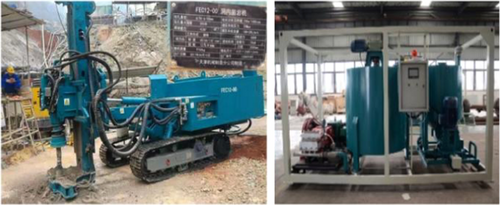
Second, a complete set of antiseepage construction technology for 130 m high discontinuous wide gradation dam body is proposed. (1) The technique of drilling trenches for cut-off walls with a depth of more than 100 m in landslide dams has been developed, and the method for forming trenches for cut-off walls of barrier bodies and the method of rapidly forming cut-off walls for barrier bodies have been proposed for the first time. (2) Innovating the “improved drilling and splitting method” construction method technology, built an antiseepage retaining dam of “137 m deep cut-off wall in the main riverbed section + 125 m deep controllable curtain grouting combination of the ancient landslide on the left bank,” forming an ultradeep new construction method of air-lift hole cleaning in the groove section of concrete cut-off wall (ground connection wall). Third, a complete set of construction technology of automatic pipe removal and “drilling-pulping-grouting” construction technology of over 100-m-level landslide dam cut-off wall under complex geological conditions has been developed. (1) Researched and developed the construction technology and equipment of a fully automatic intelligent tube pulling machine (automatic intelligent tube pulling machine) for the 100-m-level loose landslide dam cut-off wall, which realizes early warning of lifting pressure, automatic clamping and jacking, and automatic falling of the frame, and so forth, improve the level of construction automation and exception handling. (2) Developed a complete set of anti-seepage construction technology for “drilling-pulping-grouting” dams. Proposed the self-adaptive grouting control method for landslide dams, invented the programmable logic controller (PLC)-based automatic slurry delivery system and technology, and improved the grouting efficiency of discontinuous wide-graded granular dams; developed an intelligent pulping control system based on PLC and the full hydraulic grouting pump control system improves the grouting quality of the landslide dam, and forms the construction method of “comprehensive grouting method for landslide dams” that adapts to complex geological conditions, and solves the problem of curtain grouting construction in ultradeep and complex geological conditions. (3) Invented the rapid construction method of the damming body antiseepage wall to prevent concrete from sticking to the pipe wall, effectively avoiding the phenomenon of concrete sticking to the pipe wall of the joint pipe when the joint pipe is pulled out after concrete pouring, speeding up the construction progress of the wall and improving the construction efficiency which enhances engineering joint quality.
2.7 Evaluation method of landslide dam operation safety operation
The safety operation evaluation of landslide dams is an important method and means to ensure the safe operation of barrier dams. The development and application of safe operation platforms will provide important support and guarantee for the long-term safe operation of landslide dams.
2.7.1 Research and development of landslide dam safety monitoring and reserve equipment
This project has developed three sets of new monitoring instruments and equipment for landslide dams, and established a dynamic safety monitoring system for the entire life cycle of landslide dams-foundations-high slopes. (1) New deformation monitoring instruments such as the real-time collection and analysis method of landslide dam construction information based on the monitoring point space, the distributed flexible deformation monitoring of the cutoff wall, and the noncontact monitoring of the internal deformation of the dam body have been developed, as shown in Figure 12. (2) Developed new high-precision monitoring equipment for landslide dam cut-off walls and internal deformation of the dam body based on distributed optical fiber sensing technology, which solved the difficult problem of accurate monitoring of landslide dam cut-off walls. (3) Using postmounted, flexible distributed, optical fiber measurement, InSAR and other monitoring technologies, a full-life integrated dynamic safety monitoring system for landslide dams-foundation-high slopes has been established, realizing all-round, whole-process, and information dynamic monitoring provides a safety guarantee for emergency rescue, construction and operation management of landslide dams.
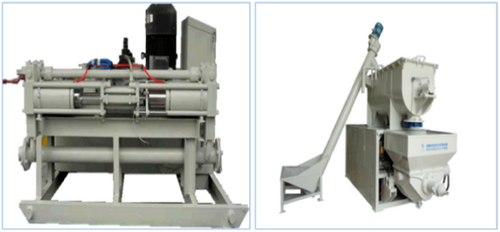
2.7.2 Research and development of landslide dam safety assessment early warning and monitoring reserve equipment
This project has built a barrier dam safety operation evaluation technology system and a life-cycle safety early warning model, and developed an intelligent safety early warning platform. (1) During the operation of the barrier dam, by monitoring various indicators during the operation of the dam, such as stress, deformation parameters, seepage, and so forth, analyze which indicators are the key indicators that affect the safety of the dam, and determine the value of each indicator within a reasonable range, when an indicator reaches or exceeds the threshold, an alarm can be issued in time. Based on the generalized entropy method, neural network method and fuzzy analytic hierarchy process, the safety evaluation index system and safety warning model of barrier dams are established, and the determination methods of warning indicators, warning weights, and warning thresholds are analyzed. (2) Adopt BIM+GIS, Internet of Things, mobile communication, and other technologies to develop and build an intelligent and safe operation platform for the entire life cycle of landslide dams, which realizes real-time monitoring, intelligent analysis, and auxiliary decision-making, and improves project safety management and risk prevention and control capabilities (Figure 13).

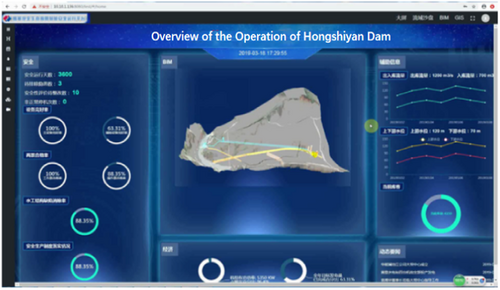
3 DEVELOPMENT AND UTILIZATION STATUS OF HONGSHIYAN LANDSLIDE DAM
The project started in August 2014, and the first unit put into commission in June 2020. After 6 years of joint research, the project team pioneered a complete set of key technologies for the barrier dam “emergency rescue-follow-up disposal-development and utilization,” and built a set of flood control, water supply, irrigation, the Hongshiyan landslide dam water conservancy project with significant comprehensive social benefits such as power generation is shown in Figure 14. Since it was put into commission, the project performed well, with a cumulative power generation of more than 1100 GWh, water supply for more than 80,000 people, irrigation of more than 66,000 mu, and direct economic benefits of more than 400 million yuan; the flood control standard has been raised to 2000 years return, which has significantly improved the safety level of the Niulan River basin, clean electricity can save 310,000 tons of coal and 790,000 tons of carbon dioxide emissions every year, and the comprehensive social benefits are particularly significant.
On January 15, 2023, the Hongshiyan Landslide Dam Water Conservancy Project was selected into the list of “People's Water Control Centennial Achievements” project list by the Ministry of Water Resources of China. The Hongshiyan project of rescue and disaster reduction and development disaster prevention have set a new model for any countries to learn to treat barrier lake (Figure 15).
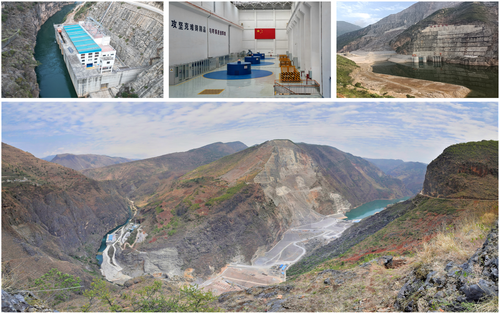
4 CONCLUSION AND OUTLOOK
The project results are applied to emergency rescue, follow-up disposal and development and utilization of Hongshiyan barrier lake, and are popularized and applied to emergency rescue of Baige and Jiala barrier lakes. The rationality and science of the results have been verified through the back analysis of the flood process of Yigong, Tangjiashan, Xiaogangjian and other barrier lakes, and the application value of science and technology is outstanding. At the same time, key technologies such as comprehensive development and utilization of landslide dams and their applicability can still be further improved. The accumulation shape of landslide dams is affected by factors such as source components, sliding distance, and sliding surface size, and the structural characteristics vary greatly. In the process of renovation, development, and utilization of the Hongshiyan landslide dam water conservancy project, a unique new model of “emergency rescue-follow-up disposal-development and utilization” integrating emergency rescue and disaster reduction and development and disaster prevention has been established, creating a “disaster reduction and prosperity.” The technical system of disaster prevention and mitigation engineering in the life cycle of landslide dams and the new model of watershed safety and green development have distinctive technical characteristics. However, the comprehensive development and utilization of landslide dams need to consider many factors such as technical feasibility, economic viability, and regional economic and social development needs. The general applicability of the comprehensive development and utilization evaluation theory and key technology system, such as dam antiseepage, construction technology and equipment, and safe operation evaluation, can still be further improved.
The establishment of a technical standard system for emergency rescue and development and utilization of landslide dams is promoted; to improve its wide application in landslide dam projects with guaranteed safety and good hydraulic resource conditions continuously, and continuously improve the international applicability of landslide dam disposal and development and utilization.
ACKNOWLEDGMENT
This study was funded by the National Key R&D Plan Project of PRC (2018YFC1508500).
ETHICS STATEMENT
None declared.
Open Research
DATA AVAILABILITY STATEMENT
Encourages data sharing.



